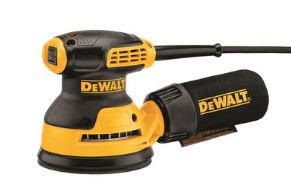Next we use a Stanley Sureform to really shape the slopes to what we need.
As you can see it makes quite a mess.
This is the Stanley Sureform. It's like a cheese grater for foam.
The other end attaches to the sander so I am vacuuming up dust as I sand. Duct tape is your friend here.
My new Sander.
We are very serious about the dust as it is toxic. So we always wear dust filters and I have fans blowing across the table and another fan in the window sucking air out of the basement.
Here is my sanding in action.
We use 2 guns so we can get glue on large boards before the glue starts to cool. We use brick to hold the boards down while the glue cools and we move the next piece to glue down.
All the levels glued down
With the gluing done, we need to smooth out the elevation changes.
For that we use Lightweight Spackle.
It's great at covering mistakes and smoothing the edges.
After it drys we go back and very very lightly sand it down again.
Next up we are adding the roads. We paint out the roads and use Woodland Scenics Brown fine ballast.
We also paint the ponds to seal them for pouring later.
My friend Lou sculpted up about a dozen buildings for this table. We need over 100 so we are going to cast them up. This is a 2 part mold making rubber that I picked up at the local hobby store.
I glue the buildings to a ceramic tile. Then I build a dam around the buildings with Lego's(Thanks Hirst Arts for "How to" instructions). Mix the 2 parts of the rubber and pour.
Once it sits over night I pull out the originals and I start casting.
To cast I use Merlin's Magic Plaster. It's a little expensive but the de-mold time is fantastic, About 15 minutes.
We are working tonight so I should have more to post tomorrow.
Thanks from the Project Austerlitz Team.























Great post - the casting process sounds nice and simple. Use of Lego is a great idea. How durable is the rubber mould? Great project, looking forward to seeing more.
ReplyDeleteThis comment has been removed by the author.
ReplyDeleteThanks Oswald. I can't take credit for the legos. I got that from Hirst Arts molds. If you are interested in doing your own casting. That is the place to start.
ReplyDeleteHi
ReplyDeleteMe again
Looking forward to seeing how you will do the frozen lake and streams.
Really impressed so far and following with great interest.
Regards
Robert